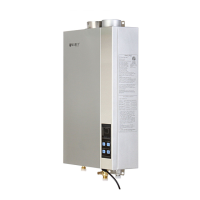1918
Routine Inspection
The heater and exhaust piping will be hot during and shortly after
use. Use caution when working in the area around the
heater.
To keep your water heater operating optimally please refer to the below
recommended inspection and maintenance checklists. We recommend a periodic
inspection performed by a qualified service technician. An annual inspection is
normally sufficient. Frequent visual inspections by the owner are also
recommended. Any repairs should be performed by a qualified service technician
using only factory authorized components. Contact qualified technician for
assistance.
Routine Inspection Checklist
Any flammable materials in the vicinity of the water heater or exhaust piping?
Any unusual noises coming from the heater while in operation?
Are the air intake and exhaust free from any blockage or foreign objects?
Any signs of water leaking near heater or pipes?
Any abnormal appearance to unit casing?
Any Discharge from Relief Valve?
Maintenance Checklist
Clean outside of unit and control panel.
- Use a wet cloth to remove any surface dirt. Use a dry cloth to wipe it dry.
- A very mild detergent may be used if unit is very dirty.
- Never use any petroleum based cleaners or solvents. These solvents can
damage the panel.
Check and clear Air Intake of any debris that might impede air flow.
Clean inlet water screen.
Cold Weather with Potential Freezing Temperatures
Keep water flowing through the system to guard against freezing.
Follow these steps:
1. Close the fuel gas valve.
2. Turn off the power by pressing the “ON/OFF” button. “CL” will be displayed when
off.
3. Open the hot water faucet at one or more points of use (sink, upstairs bathtub,
etc.) Maintain a constant trickle. Monitor the stream of water to ensure it is still
flowing.
No Flow Due to Expected Frozen Heater
1. Close both the fuel gas valve and the water inlet valve.
2. Turn off the power switch.
3. Open a hot water faucet.
4. Open the water inlet valve now and then to check for a water flow.
5. If no flow, attempt to thaw heater by using a portable heat source such as a hair
dryer or portable electric heater.
6. Check occasionally to see if water flow has started.
7. When water flow resumes, carefully check for any signs of water leakage.
8. Resume normal operation.
To prevent damage, NEVER force a heater to operate while in a
frozen state. NEVER bypass any safety feature.
Warranty
Damage caused by freezing is NOT covered by Warranty.

